From Triana to the Mezquita: An Escape Through Southern Spain
What happens when you trade guidebooks for gut instinct, and follow the sound of flamenco instead of Google Maps?
21 ESCAPESSPAIN
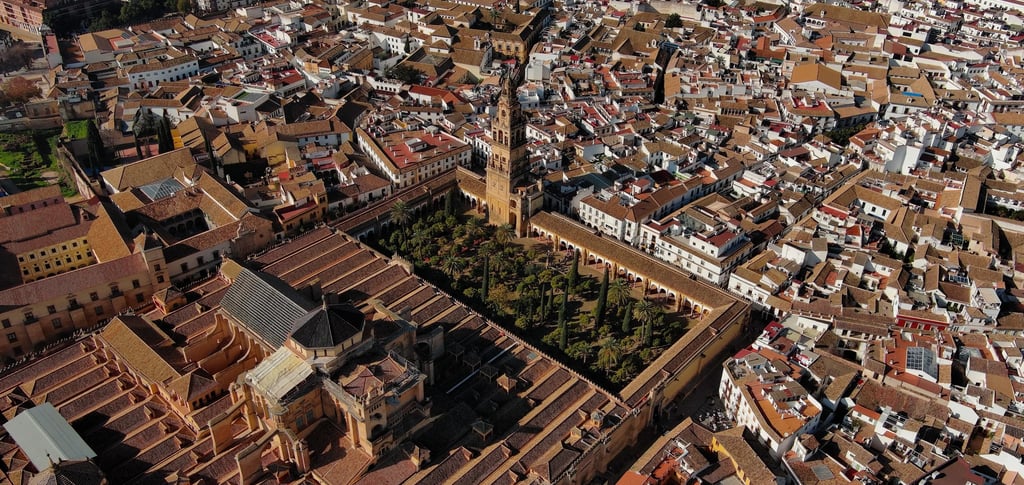

It was the heat that hit us first—thick, golden, and sweet, like honey warming your skin. But more than that, it was the sound. The clack of heels on cobblestone, the rustle of orange leaves in courtyards, the deep wail of a flamenco singer rolling out from a dimly lit bar in Triana. From the moment we stepped off the train, Seville unfolds like a dance.
The Rhythm Across the River – Old Town to Triana and Back
The morning sun spilled across the stone walls of our hotel—Hotel Casa 1800, a restored 19th-century mansion with balconies that peeked toward the Giralda tower, just steps from the Cathedral. We’d barely dropped our bags before the sounds of Seville began to pull us outward: church bells chiming in harmony with clinking cups of café con leche, the low hum of footsteps on ancient cobblestones, and the perfume of orange blossoms in every plaza.
A quick breakfast—tostada con jamón and fresh tomato—at La Cacharrería, and we were off. The Avenida de la Constitución led us straight to the Puerta de San Telmo, where we veered toward the Puente de Triana. The walk to the bridge alone was worth slowing down for. Street performers danced beneath the shade of the Torre del Oro, and horse carriages clacked past, their drivers calling out in Andalusian drawl.
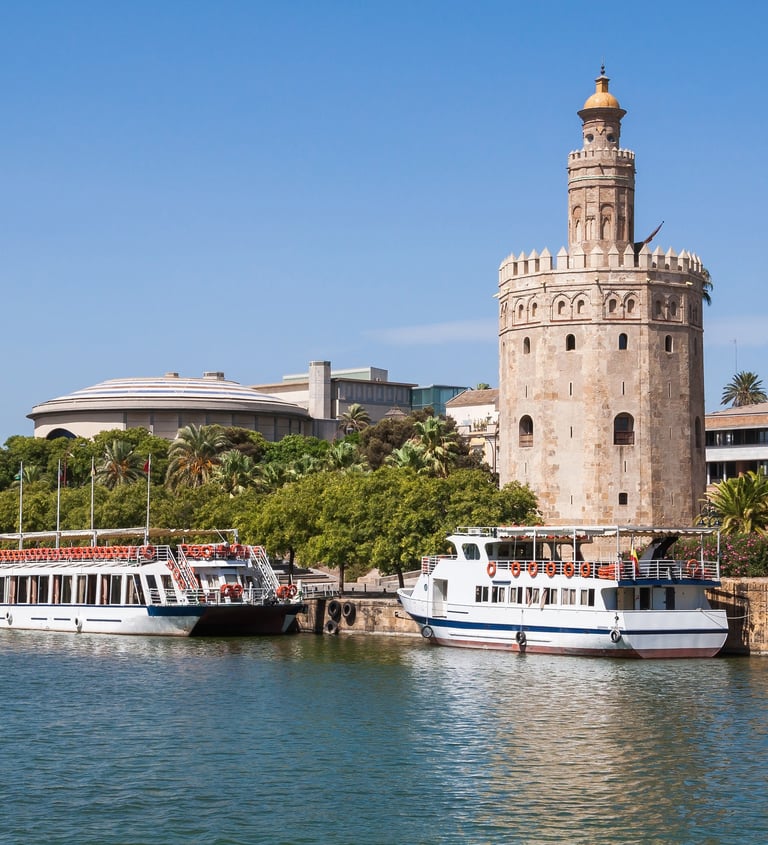

Crossing the Triana Bridge, we paused mid-span, taking in the view: the Guadalquivir lazily flowing between two sides of a city that each seem to dance to their own rhythm. On the far side: Triana, Seville’s earthy, soulful sister, where the buildings blush in ochres and blues, and every balcony blooms with life.
Our first stop was the Triana Market, built atop the ruins of a castle that once housed the Inquisition. Now, it’s a feast for the senses. We sampled olives marinated in orange zest, sipped cold vermouth with a twist, and bought a paper cone of chicharrones to nibble as we explored. Locals chatted about football and family over plates of salmorejo and tuna loin. A small shop in the corner even sold handcrafted tiles with flamenco silhouettes and Andalusian sayings—each one a slice of Triana’s identity.
After visiting the Centro de la Cerámica, we walked along the riverside promenade of Calle Betis. Terraces spilled with laughter and music. We stopped at La Tertulia again for a midday tinto de verano, the river sparkling beside us, the Giralda watching from across the water like a queen on her throne.
By mid-afternoon, Triana’s heat had slowed us down. We wandered through Calle Pureza but as golden hour began to creep over the rooftops, we made our way back across the bridge—Seville’s skyline glowing now, the Cathedral lit from within.
Back in the Barrio Santa Cruz, the night felt electric. We passed orange trees twinkling with fairy lights and followed the laughter to Bodega Santa Cruz (Las Columnas), a local tapas bar with standing room only, no frills, no fuss. We jostled in with the crowd, pointing at chalkboard menus and sharing plates of espinacas con garbanzos, bacalao, and berenjenas fritas with honey. Glasses of ice-cold Cruzcampo clinked around us.
For a more relaxed second round, we strolled down Calle Mateos Gago to Ovejas Negras Tapas, a modern fusion spot with Andalusian roots. Their truffled huevos rotos and pork cheek tacos? Worth every bite.
By midnight, the Cathedral loomed serene and ghostly in the moonlight as we sat in Plaza del Triunfo, digesting the day. Flamenco notes drifted from a distant courtyard, carried on the breeze like a memory. It had only been one day, but Seville had already worked its way under our skin.
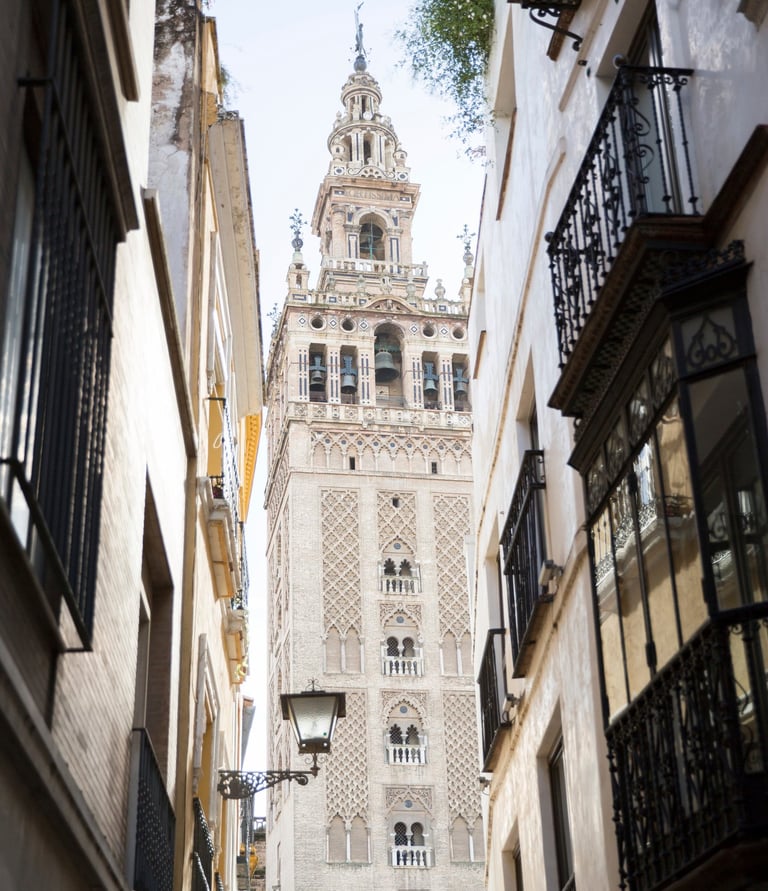

Royal Splendor, Rooftops, and the Fire of Flamenco. We woke to the soft echo of church bells and the slow crescendo of life unfolding in the alleys around Hotel Casa 1800. Breakfast was served in the courtyard beneath iron balconies and trailing bougainvillea—fresh orange juice, Andalusian cheese, and pastries still warm from the oven.
Just a few steps from the hotel stood the entrance to the Real Alcázar, a palace so beautiful it feels like it grew out of the Andalusian earth. We joined the early crowd, wandering beneath horseshoe arches, through whispering fountains and tile-covered walls that shimmered like mosaics of stars. The Patio de las Doncellas was quiet in the morning light, and we stood there imagining what it must’ve been like when Moorish sultans and Christian kings paced these very stones. The scent of orange blossoms followed us into the Jardines del Alcázar, where peacocks strutted like they knew the secrets of the city.
By noon, the city had warmed to a slow burn. We crossed into Santa Cruz, weaving through its labyrinth of streets where the sun barely touches the ground. Every turn revealed another tiny square—Plaza de Doña Elvira, with its tiled benches and air thick with jasmine, and Plaza de los Venerables, where we paused for a coffee under a shady tree.
Lunch took us to La Bartola on Calle San José, one of those places that looks unassuming until you taste the food. We shared tataki de atún, roasted eggplant with tahini, and their famous goat cheese salad with crispy jamón. Locals filled every table, and we stayed longer than planned, watching the rhythm of Seville pass us by.
Late afternoon was perfect for a slow climb—not a mountain, but the Giralda Tower. From the top, Seville sprawled in every direction: the river glinting like a trail of silver, the Maestranza Bullring curled like a coiled shell, and the rooftops tiled in terracotta waves. The sun was beginning to soften, casting gold onto every spire and balcony.
Back on ground level, we strolled past the Archivo General de Indias, its façade a quiet witness to centuries of voyages and empires. Then we dipped into the Hospital de los Venerables, a baroque jewel that most travelers miss, with its chapel frescoed in bold color and its calm, contemplative courtyard.
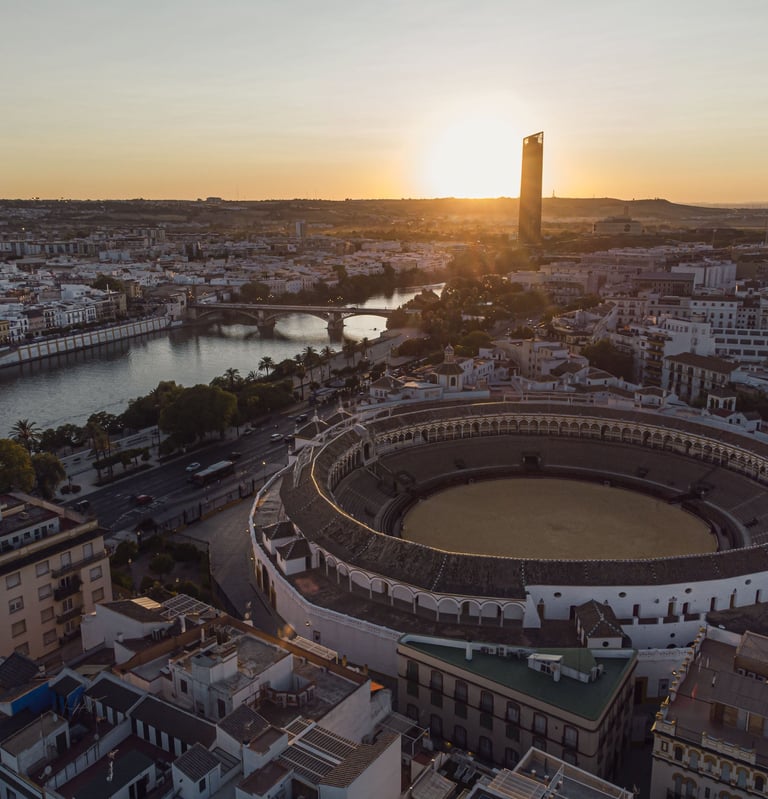

We weren’t quite ready for dinner yet—so we did what Sevillanos do. We lingered. We wandered. As twilight rolled in, we made our way toward Plaza del Salvador, one of the liveliest spots in the city. People stood outside bars with glasses of wine balanced on iron barrels, kids played in the square, and laughter bounced between centuries-old walls.
We began our tapas crawl at El Comercio, a traditional bar that’s been open since 1904. Their croquetas caseras and simple, perfectly spiced espinacas con garbanzos were unforgettable. From there, a quick walk led us to La Brunilda, a modern favorite with dishes like crispy eggplant and tuna tartare that reminded us Seville knows how to blend old and new.
But the highlight of the night? Casa de la Memoria, a flamenco performance space hidden behind a wooden door on Calle Cuna. No microphones, no flashy lights—just the raw sound of a flamenco guitar, the wail of the singer, and a dancer who seemed to move with the city’s heartbeat. Her footwork echoed centuries, her face contorted with emotion, her dress trailing sparks. The small audience sat spellbound. There was no need for applause—what we’d just seen wasn’t a show. It was a ritual.
We ended the night back near Plaza Nueva, sitting on a quiet rooftop terrace with gin tonics in hand. From here, the Cathedral glowed softly in the distance, and Seville felt like a secret we were lucky enough to be let in on.
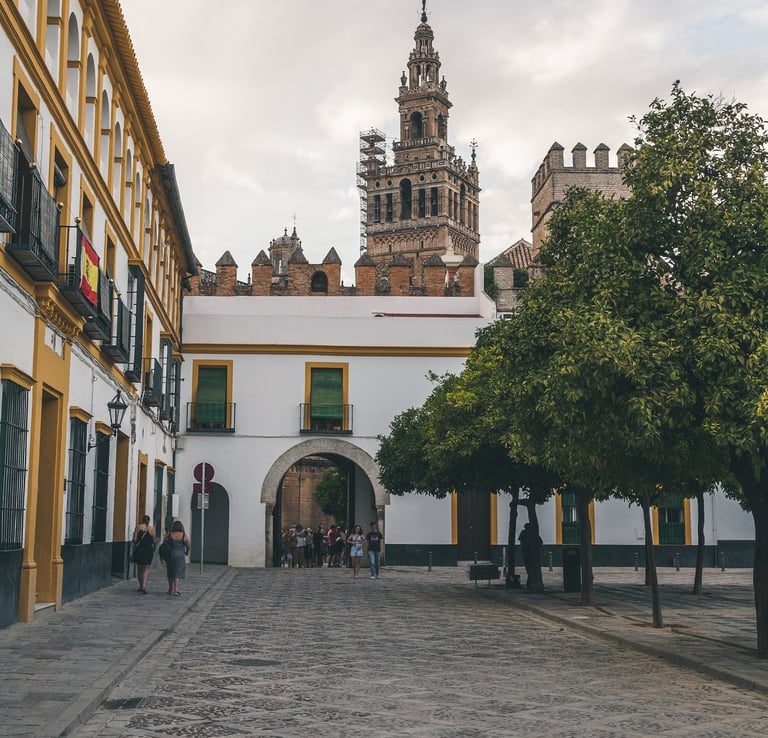

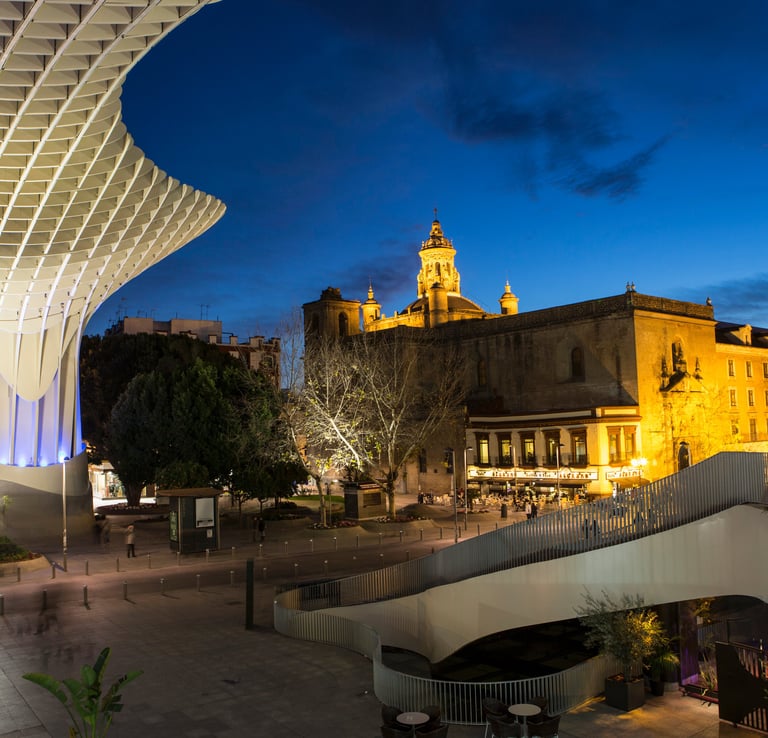

Next day, We started slowly, letting the sun climb before we did. Seville teaches you that time doesn’t rush here—it simmers. After breakfast at Paradas 7, a cozy café near our hotel where the toast comes with real tomato pulp and olive oil sharp enough to make you sit up straight, we set off south toward one of Seville’s most majestic sights.
The walk to Plaza de España is an experience in itself. We strolled past flower-laced balconies and through the shaded avenues of Avenida de la Constitución, then down into the wide entrance of Parque de María Luisa—once the private garden of a duchess, now a cool, green sanctuary. Under the canopy of palms and jacarandas, we passed cyclists, old couples on benches feeding birds, and children chasing each other around tiled fountains shaped like stars. The air smelled of pine and orange blossom, and somewhere a guitar played softly.
Then, like something out of a dream, Plaza de España revealed itself—massive, curved, golden. Horse carriages circled the semicircular building, its bridges arching over the moat like something from Venice, but all Andalusian. Every province of Spain was represented in ceramic tile along the base. We spent an hour tracing the map of a nation in porcelain. A flamenco guitarist strummed under one of the archways, his song bouncing off the colonnades as paddleboats floated gently in the moat.
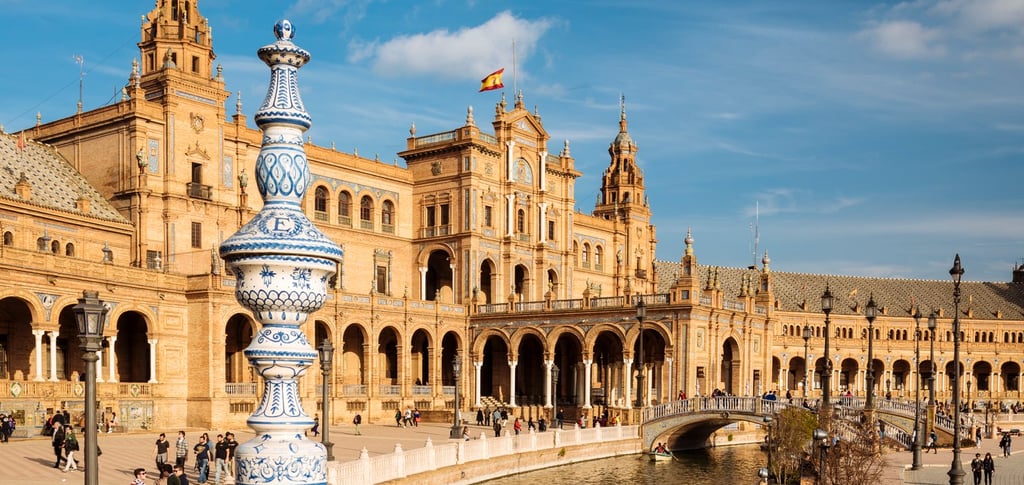

Next day, We started slowly, letting the sun climb before we did. Seville teaches you that time doesn’t rush here—it simmers. After breakfast at Paradas 7, a cozy café near our hotel where the toast comes with real tomato pulp and olive oil sharp enough to make you sit up straight, we set off south toward one of Seville’s most majestic sights.
The walk to Plaza de España is an experience in itself. We strolled past flower-laced balconies and through the shaded avenues of Avenida de la Constitución, then down into the wide entrance of Parque de María Luisa—once the private garden of a duchess, now a cool, green sanctuary. Under the canopy of palms and jacarandas, we passed cyclists, old couples on benches feeding birds, and children chasing each other around tiled fountains shaped like stars. The air smelled of pine and orange blossom, and somewhere a guitar played softly.
Then, like something out of a dream, Plaza de España revealed itself—massive, curved, golden. Horse carriages circled the semicircular building, its bridges arching over the moat like something from Venice, but all Andalusian. Every province of Spain was represented in ceramic tile along the base. We spent an hour tracing the map of a nation in porcelain. A flamenco guitarist strummed under one of the archways, and two women lit up the square with flamenco, fierce, focused, and totally in sync with the city around them.
From there, we slipped back into the park and found a shaded bench with a view of the Fountain of the Lions. It was the perfect place for a break—some tinto de verano and a few slices of jamón we’d picked up earlier at a deli. In the afternoon heat, we headed to the Museo de Artes y Costumbres Populares, housed in a Mudejar palace right in the park. It’s a beautiful, underrated gem, filled with colorful costumes, traditional instruments, and displays that offered a peek into the soul of Andalusian life across centuries. On the way back toward the Old Town, we made a detour through the Soho Benita district—a creative, boho neighborhood full of tiny shops, art galleries, and design studios.
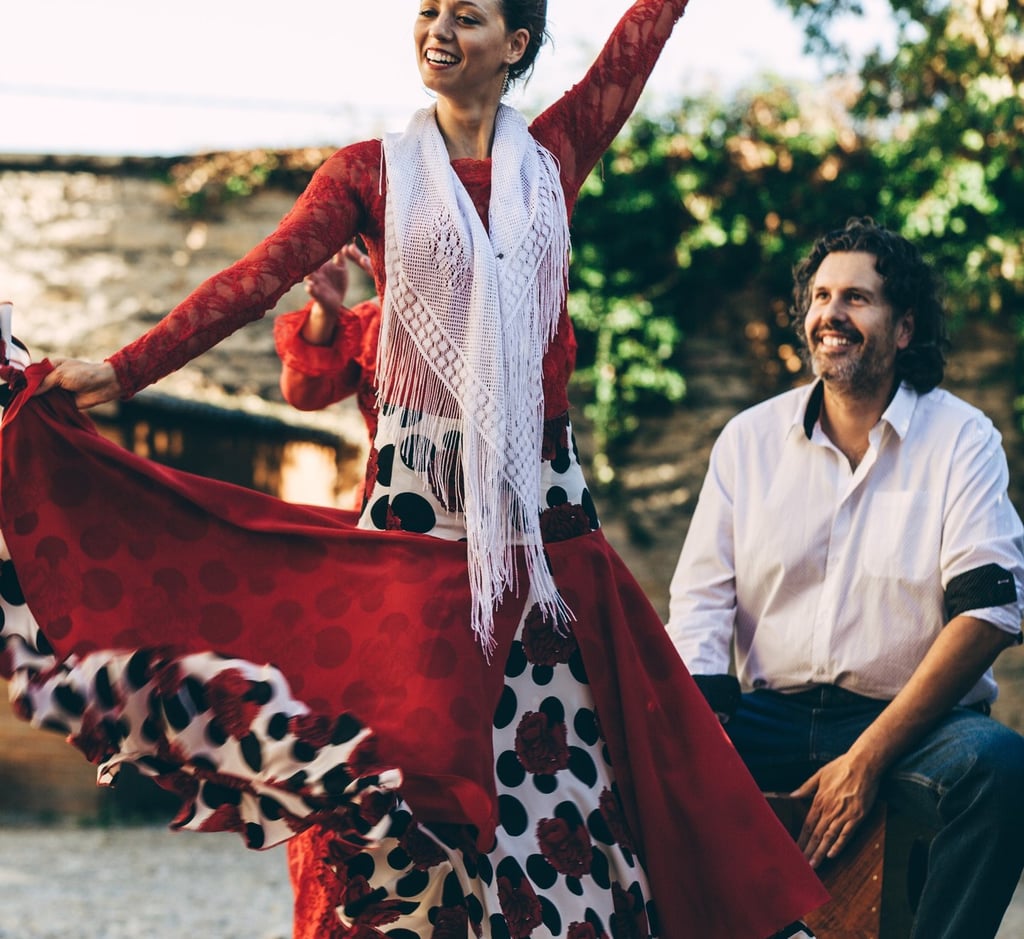

Night fell like a velvet curtain, and Seville changed gears. The heat eased. The streets shimmered.
We began with a round of tapas at Bodega Morales, one of the oldest taverns in Seville. The place smelled of sherry barrels and old wood. We ordered montaditos, chorizo in wine, and the house manzanilla. Locals leaned over the bar shouting their orders. The waiter scribbled our bill in chalk on the counter. Outside, the city was alive. In a narrow alley near Calle Mateos Gago, we found a group of young men in traditional tuna costumes—velvet jackets, ribbons, and lutes—serenading a group of wide-eyed tourists with age-old songs of love and mischief. We stayed and clapped along, enchanted.
As we wandered, drawn by clapping and laughter, we stumbled upon another tiny tavern—Taberna Gonzalo Molina, no stage, no sign, just a doorway filled with music. Inside, a group of locals dancing, clapping in rhythm, their shoes tapping out stories we didn’t understand but instantly felt. We were invited to join, and we did—badly, joyfully.
By midnight, we wandered through the cool streets of Barrio Santa Cruz, guided by lantern light and the echo of distant guitars. We passed hidden patios and balconies dripping with vines. Back at the hotel, we poured one last glass of wine and toasted to a city that doesn’t just show you her face—she makes you dance with her, laugh with her, feel her heartbeat in every tile and note of song.
We left Seville just after breakfast, still buzzing from the night before. The Renfe high-speed train whisked us toward Córdoba in under 45 minutes, gliding through olive groves and golden hillsides that looked like they hadn't changed in a thousand years. Arriving at the Córdoba train station, we stepped into a slower rhythm. The city felt quieter, wrapped in morning light and Moorish echoes. The streets were warm and hushed, as if holding their breath for us to arrive. We skipped the taxis and walked. It was only 30 minutes to the historic center, and every step took us deeper into a time warp of whitewashed alleys, flower-draped patios, and cool stone arches. A brief detour down Calleja de las Flores, one of the most photographed spots in Spain, gave us a postcard view of the Mezquita’s bell tower framed by blooms.
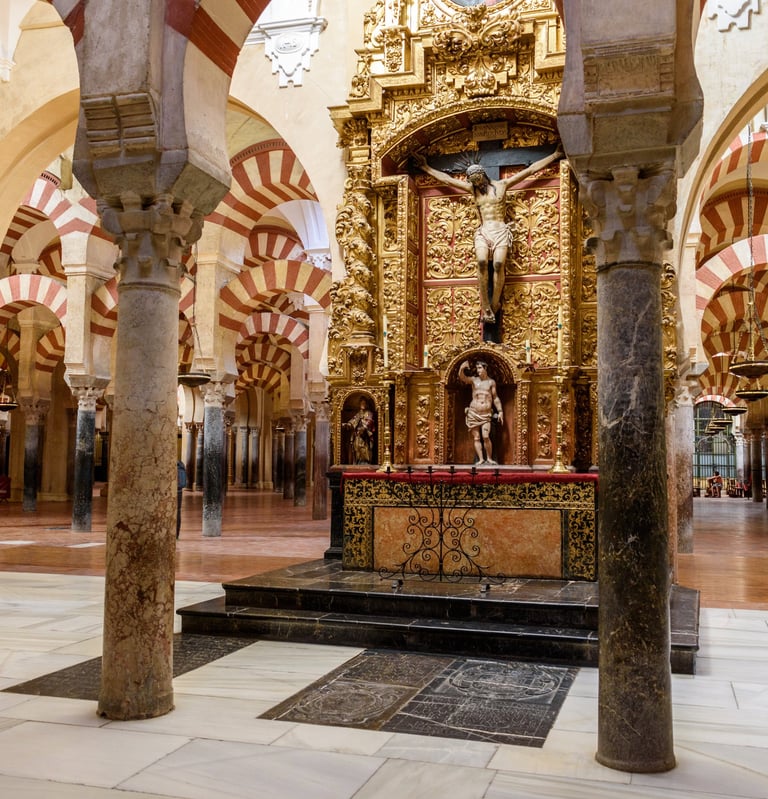

And then it was there—the Mezquita-Catedral, one of the most breathtaking places we’ve ever seen. From the outside, it looked like a medieval fortress, but once inside, we stepped into a hypnotic forest of red-and-white striped arches that stretched as far as the eye could see. Built as a mosque in the 8th century, then later transformed into a cathedral, it’s a place where history doesn’t just live—it breathes in patterns of light and shadow.
We walked silently, awe-struck by how the architecture seemed to fold time into itself. The mihrab gleamed in gold, still intact after centuries. And right in the middle? A soaring cathedral nave—Christian grandeur embedded in Islamic serenity.
After the Mezquita, we wandered through the Judería, Córdoba’s old Jewish Quarter. Its winding streets led us to hidden patios full of geraniums and quiet fountains. We visited the small but poignant Córdoba Synagogue, one of only three remaining medieval synagogues in Spain. For lunch, we found a table in the leafy courtyard of Casa Mazal, a restaurant dedicated to Sephardic cuisine. We shared dishes of lamb with dates and cinnamon, berenjenas con miel, and stuffed grape leaves. It was light, fragrant, and rich in stories from cultures long intertwined.
After lunch, we crossed the Roman Bridge, the Puente Romano, as the afternoon light danced on the river. The Torre de la Calahorra rose at the far end like a sentinel. We climbed to the top for a panoramic view of Córdoba—its red roofs, the curve of the Guadalquivir, and the golden dome of the Mezquita catching the sun one last time. On the way back, we stopped for a final refreshment at Sojo Ribera, a modern terrace bar with a view of the bridge and the Mosque-Cathedral. Two glasses of Montilla-Moriles, the local sherry-like wine, and it was time to get back to the station for the return to Seville.
Our last morning in Seville arrived quietly. The city, always vibrant, seemed to move a little slower as if reluctant to see us go. We packed in silence, the open window letting in the soft clang of church bells and the faint scent of orange blossoms one last time.
After a final stroll through Plaza del Triunfo, The Santa Justa train station was calm, organized, and just a short cab ride away. We boarded the AVE high-speed train to Madrid, settling into plush seats as Seville slipped past the window like a dream we had just lived.
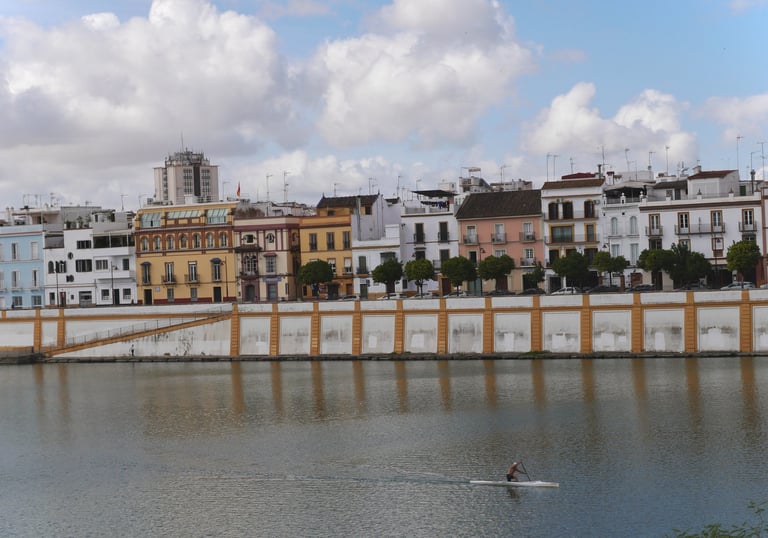

Crunia Travel
Customized travel experiences await you.
Get in touch
hello@cruniatravel.com
+1 754 457 2624
© 2025. All rights reserved.


admin@cruniallc.com
